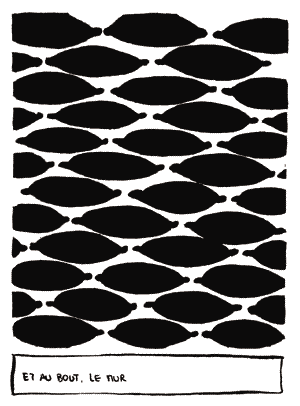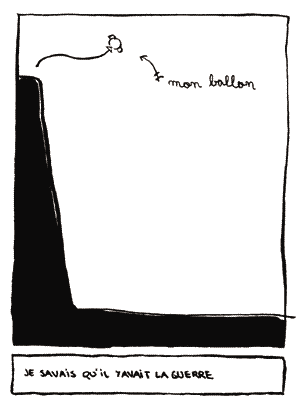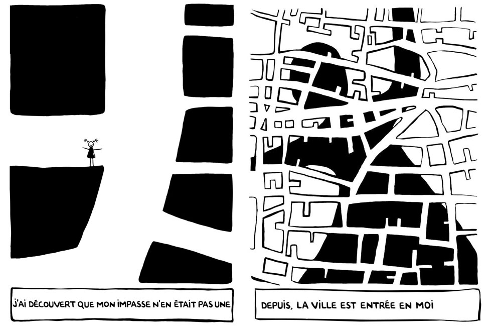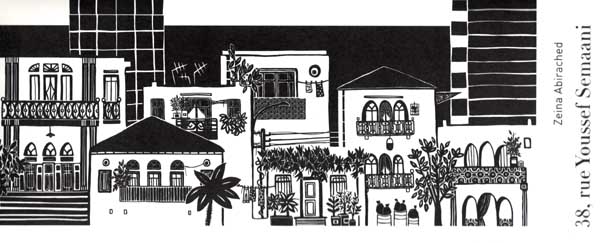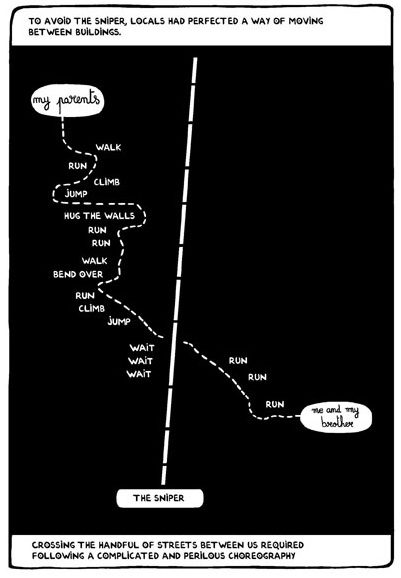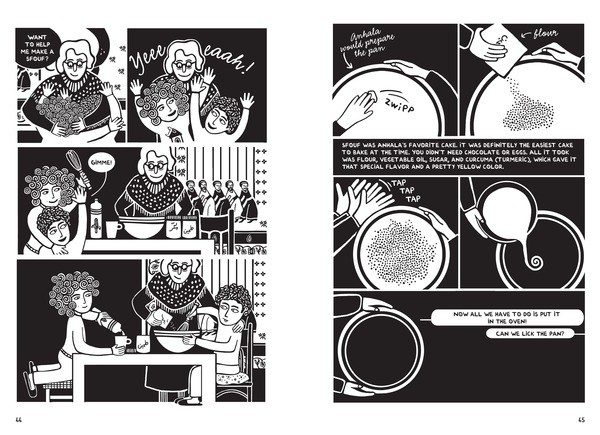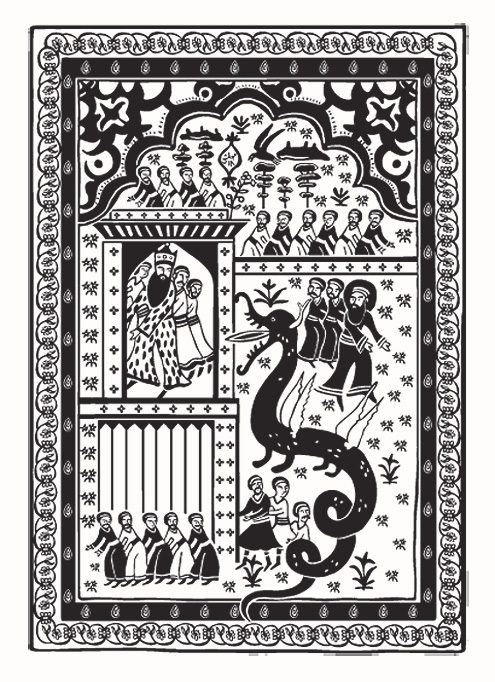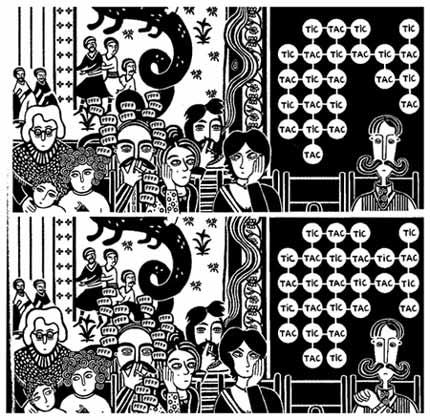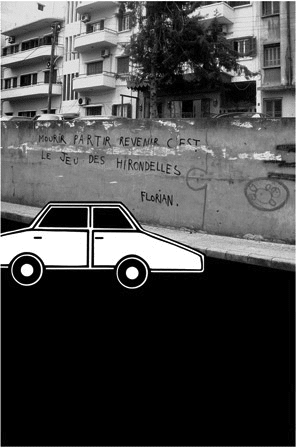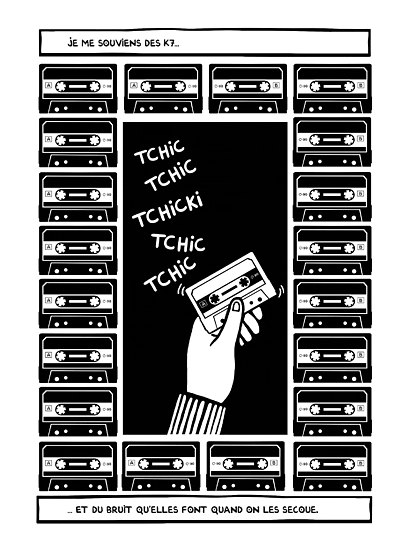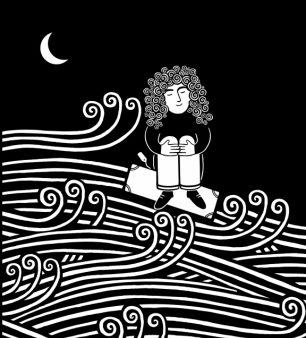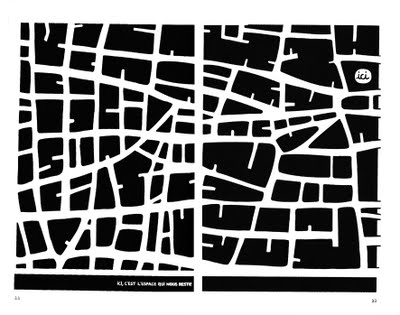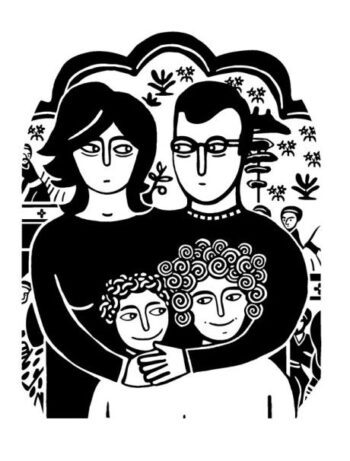
The New York Comics & Picture-Story Symposium is a weekly forum for discussing the tradition and future of text/image work. Open to the public, it meets Monday nights at 7-9pm EST in New York City. Presentations vary weekly and include everything from historical topics and technical demonstrations to creators presenting their work. Check out upcoming meetings here.
ZEINA ABIRACHED
Zeina Abirached began her talk by summarizing the facts of her childhood: “My first ten years was war,” she explained. The Lebanese civil war that engulfed her childhood started in 1975, and Abirached, the eldest of two children, was born in East Beirut in 1981. The civil war would not end until 1990. Her family lived at 38 Rue Youssef Semaani, and at the end of her street was a huge wall which kept her neighborhood “amputated,” as she said, from the rest of the city. The wall impeded their ability to move about, and more importantly, was a daily reminder that they lived in the midst of conflict.
The wall and its later absence were of seminal importance in Abirached’s life. Years after the war ended, when she was about 21, she found herself disoriented and apparently lost in the city. Actually, she was close to home, but in a section that had been previously inaccessible due to the wall. The wall was gone, but she had continued to navigate the city as if it remained. She couldn’t recall when it had been torn down, nor, when she asked, could her neighbors.
This was important, as Abirached emphasized, because despite Beirut’s history of war, it has no memorial, no monument to it. The books in the schools do not teach it as there is no officially sanctioned version to teach. Her comics are her attempt to remember and her personal tribute to memory in a city that has edited its past.
Abirached’s first book, Beyrouth Catharsis (Beirut Catharsis), is autobiographical and told entirely from a child’s point of view. It relays the strange and often sad details of growing up in a combat zone. Abirached’s mother, to calm her children, would tell them, “when you hear the snipers, it is just hunters killing birds.” So both sister and brother feared for all the birds, and believed that their neighbor who kept birds in cages was keeping them safe from the bullets.
As a child, she released a balloon and watched it go over the wall. It was the first moment she became conscious that there was another side, a city beyond.
Aribrached explained that her book is an attempt to express how the walls and barriers around the city were just as psychological as they were physical. As she had learned that day she became lost, the barriers continue to exist in the city’s collective memory. Though the war is over, the walls remain in the minds of its citizens.
Her next book was 38 Rue Youssef Semmani, which folds out and mimics the structure of her childhood apartment. One explores the book as one might explore a building. The stairs in the book serve as both visual and narrative connections between stories in both senses of the word. Each tenant has a story that plays out inside the space allotted to their apartment within the cartoon structure. Each story stacks upon the other as the pages unfold allowing the reader to follow them both horizontally and vertically.
Abirached also spoke of the first appearance of a character she has a lot of affection for: Ernest Challita, who, like all of her characters, was a very real person living in a very real place. Abirached emphasized how important it was to her that the title be the actual address, 38 Rue Youssef Semmani. In a city where visual indicators are used instead of addresses, where the postal service had broken down and been useless during the long civil war, where, in fact, many street names had been lost, forgotten, changed, and re-named during reconstruction, Abirached felt she needed to link the memories to a very specific time and place: an actual address in a city re-arranged.
The next book Abirached discussed was A Game for Swallows: To Die, To Leave, To Return (Mourir, partir, revenir – Le Jeu des hirondelles), the only one of her books to be translated into English so far. The inspiration for the book came when she by chance found a news report from 1984 on the Internet. The reporter was interviewing a woman who was standing in her doorway for protection against the shelling. Despite this she told the reporter, “You know, I think maybe we’re still more or less safe here.” The woman, Abirached realized, was her own grandmother. From this shock of seeing her own grandmother came the inspiration for the book, which takes place entirely in one room of her childhood apartment in Eastern Beirut, over the course of one night of heavy shelling.
Abirached explained that as the conflict wore on, fewer and fewer rooms in their home were deemed safe to occupy, until they lived entirely in the foyer. Cooking, sleeping, eating, living, all happened in one room. The foyer was considered the safest room in the entire building, so on nights when the bombing was very bad, those neighbors who remained would come and join them there until the danger had passed.
As a child Abirached came to believe her safety was ensured by a tapestry in the foyer that became a sort of talisman for her. It depicted Moses leading the Jews out of Egypt and throwing his staff on the ground. In this portrayal of the story, the staff becomes a huge dragon. The dual nature of the picture ground comforted Abirached: the pharaoh and the danger on one side, the Jews safe in the temple on the other, the huge dragon standing in a barrier between these two worlds. As a child she felt that where the Jews were was the same bubble that she and her family inhabited, the bubble of the building where they were safe, where all life happened.
Much of the book details the distractions and routines they employed to work around the various deprivations experienced in wartime, such as lack of water, electricity, fresh food, or telephones.
The book introduces each of her neighbors and how they coped and compensated for a world in chaos. Ernest Challita, the dapper professor of French, dresses impeccably as a small act of daily resistance. The beautiful married couple who have lost their home and all their belongings, attempt to name their baby something both familiar but acceptable to his inevitable life abroad in Canada where they will soon flee. In truth, the bubble is an illusion. The war is everywhere. It invades everything.
The title for the book was taken from graffiti written on a wall in what was once no man’s land. It says “To die, to leave, to return, this is a game for swallows. -Florian” (To the best of her research, Abirached believes Florian himself was a visiting Belgian dancer in the ‘90s.). Every time she returns to the city she visits the wall. To Abirached, the phrase evokes the history and people of Beirut, the destruction of war, the mass immigration out of Lebanon, and her own need both to leave and to return.
The next book discussed was I Remember Beirut (Je me souviens). Each chapter begins with the phrase, “I remember …,” as a starting point to a new story. It ties into places and moments throughout the ‘70s and ‘80s and beyond. The first shower she ever took, the first time she entered into a previously forbidden part of the city, the first time she realized that the street on the other side of the wall had the same name, as it was the same street: “It was not cut in half, it continued on.”
Q&A
The talk was opened up to the audience and Abirached was first asked what the reception of her book was like in Lebanon. She pointed out that there is no Arabic translation of her books, and that ties into why she left to write in France where there are actually publishers for graphic novels. The reception, however, has been very positive, despite the fact that comics are not commonly seen as a medium for serious subjects, and she felt compelled to explain to people that “black and white is not a lack of color.”
Many neighbors have seen the book and liked it, though Ernest Challita died a few years before it was published. Her mother, however, was horrified to learn that her daughter remembered so much of the war, and that her attempts to hide and mask a terrible reality had been unsuccessful.
Abirached had often wondered if her experience was specific to the fact that she lived so close to the Green Line, which divided the city, but found that many of her experiences were universal to others throughout her country. She was gratified to learn that even those who had grown up in West Beirut related deeply to her stories. It helped that she has kept her works fairly apolitical.
This prompted a question from the audience as to whether her memoirs therefore reinforce the national lack of conversation regarding the war. But Abirached stressed that it was important to keep it personal and specific to daily life as experienced by a child. As a writer she is interested in the universal consciousness of their shared history, not the impossibly complex and messy politics of war.
The talk concluded with a discussion regarding influences and process. She grew up reading Tintin and Asterix and her artistic influences include the comic artists Jacques Tardi, Marc-Antoine Mathieu, and David Beauchard. Though she loves comics, she retains a love-hate relationship with her drawing process. Writing is foremost in her process. Her design background influences her ability to covey complex ideas with simple graphics and she always seeks to eliminate all that is not essential. The drawings must serve the story first.
***
Image 1: Zeina Abirached, A Game for Swallows: To Die, To Leave, To Return, Graphic Universe, 2012
Image 2: Zeina Abirached, Beyrouth Catharthis, Cambourakis, 2006
Image 3: Zeina Abirached, Beyrouth Catharthis, Cambourakis, 2006
Image 4: Zeina Abirached, Beyrouth Catharthis, Cambourakis, 2006
Image 5: Zeina Abirached, Beyrouth Catharthis, Cambourakis, 2006
Image 6: Zeina Abirached, 38, rue Youssef Semaani, Cambourakis, 2006
Image 7: Zeina Abirached, 38, rue Youssef Semaani, Cambourakis, 2006
Image 8: Zeina Abirached, A Game for Swallows: To Die, To Leave, To Return, Graphic Universe, 2012
Image 9: Zeina Abirached, A Game for Swallows: To Die, To Leave, To Return, Graphic Universe, 2012
Image 10: Zeina Abirached, A Game for Swallows: To Die, To Leave, To Return, Graphic Universe, 2012
Image 11: Zeina Abirached, A Game for Swallows: To Die, To Leave, To Return, Graphic Universe, 2012
Image 11: Zeina Abirached, A Game for Swallows: To Die, To Leave, To Return, Graphic Universe, 2012
Image 12: Zeina Abirached, Je me souviens, Cambourakis, 2009
Image 13: Zeina Abirached, 2012
Image 14: Zeina Abirached, Beyrouth Catharthis, Cambourakis, 2006
Image 15: Zeina Abirached, 2012
***
About the author: Sophia Wiedeman is a comic artist and author of The Lettuce Girl series of comics as well as the Xeric wining graphic novel The Deformitory. She lives and draws in New York city. You can see her work here.


